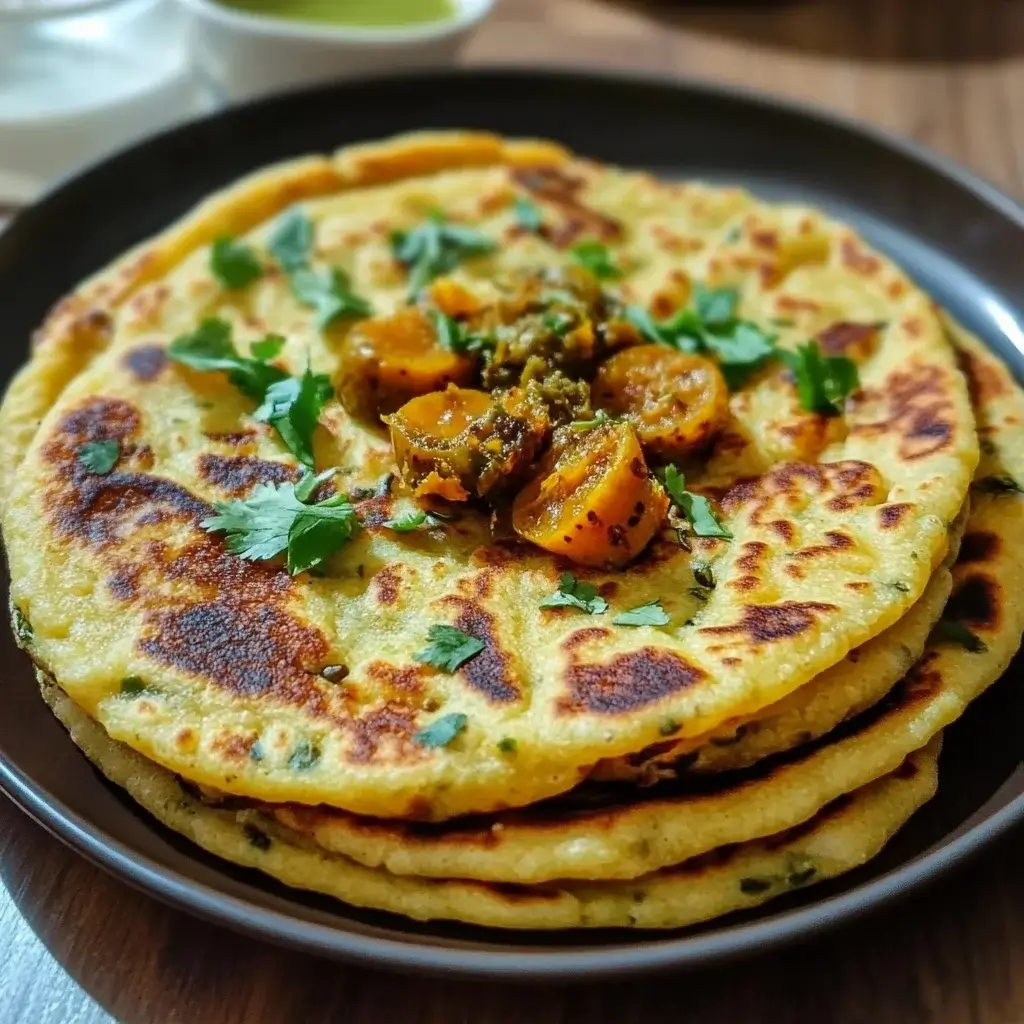There’s something truly magical about the aroma that fills your kitchen when Methi Thepla is being made. It’s an earthy, inviting scent, a promise of warmth and comfort that instantly transports me back to my grandmother’s kitchen. Recently, I decided to recreate this beloved Gujarati classic, pairing it with a tangy homemade pickle, and the result was nothing short of spectacular. My family, usually picky eaters, devoured every last Thepla, praising the soft texture and the delightful blend of spices. The pickle added a zesty kick that perfectly complemented the subtle bitterness of the fenugreek leaves. It wasn’t just a meal; it was an experience, a taste of home-cooked goodness that left us all feeling satisfied and content. If you’re looking for a recipe that’s both healthy and delicious, and brings a touch of India to your table, then look no further than Methi Thepla with Pickle. This is a dish that’s sure to become a family favorite, just as it has in mine.
Ingredients: The Heart of Methi Thepla and Pickle
To embark on this culinary adventure, you’ll need a collection of fresh and flavorful ingredients. Let’s break down what you’ll need for both the Methi Thepla and the accompanying pickle.
For Methi Thepla:
- Whole Wheat Flour (Atta): 2 cups – The foundation of our Thepla, whole wheat flour provides a hearty base and essential fiber, giving the Thepla its characteristic texture and nutritional value.
- Fresh Fenugreek Leaves (Methi): 1 cup, finely chopped – The star ingredient, methi leaves, bring a slightly bitter and uniquely aromatic flavor that is central to Thepla’s identity. Ensure they are fresh and vibrant green for the best taste.
- Gram Flour (Besan): 1/4 cup – Adding gram flour lends a nutty flavor and helps in binding the dough, contributing to the soft and pliable texture of the Thepla.
- Yogurt (Dahi): 1/4 cup, plain and slightly sour – Yogurt adds moisture and tanginess to the dough, making the Thepla softer and aiding in fermentation, which enhances flavor and digestibility.
- Ginger-Green Chili Paste: 1 tablespoon – This paste provides a spicy and aromatic kick, adding warmth and depth to the Thepla. Adjust the amount of green chilies to your spice preference.
- Turmeric Powder (Haldi): 1/2 teaspoon – Turmeric not only imparts a beautiful golden color but also offers anti-inflammatory benefits and a subtle earthy flavor.
- Red Chili Powder (Lal Mirch): 1/2 teaspoon – For an extra layer of heat and vibrant color, red chili powder is added. Adjust according to your spice tolerance.
- Cumin Powder (Jeera Powder): 1 teaspoon – Cumin powder brings a warm, earthy, and slightly smoky flavor that complements the other spices and enhances the overall taste profile.
- Coriander Powder (Dhania Powder): 1 teaspoon – Coriander powder adds a citrusy and slightly sweet aroma, balancing the spices and contributing to the complex flavor profile.
- Sesame Seeds (Til): 1 tablespoon – Sesame seeds provide a nutty flavor and a pleasant crunch, adding textural interest to the Thepla and enhancing its visual appeal.
- Oil: 2 tablespoons + for cooking – Oil is essential for making the dough pliable and for cooking the Thepla to a golden brown perfection. Use a neutral-flavored oil like vegetable or canola oil.
- Salt: To taste – Salt is crucial for seasoning and balancing the flavors in the Thepla dough.
For Quick Mango Pickle (Optional, but Highly Recommended):
- Raw Mango (Kairi): 2, medium-sized, peeled and diced – Raw mangoes are the base of this tangy pickle, offering a sour and slightly tart flavor that is perfect for balancing the richness of the Thepla.
- Mustard Oil: 1/4 cup – Mustard oil lends a pungent and distinctive flavor to the pickle, characteristic of many Indian pickles. It also acts as a preservative.
- Fenugreek Seeds (Methi Seeds): 1 teaspoon – Methi seeds add a slightly bitter and aromatic note, contributing to the complexity of the pickle’s flavor profile.
- Mustard Seeds (Rai): 1 teaspoon – Mustard seeds provide a sharp and pungent flavor, essential for the typical pickle taste.
- Turmeric Powder (Haldi): 1/2 teaspoon – Turmeric adds color, flavor, and its natural preservative qualities to the pickle.
- Red Chili Powder (Lal Mirch): 1 teaspoon – Red chili powder adds heat and vibrant color, making the pickle more appealing and spicy. Adjust to your preference.
- Asafoetida (Hing): A pinch – Asafoetida adds a unique pungent and savory flavor, enhancing the overall taste and aiding digestion.
- Salt: To taste – Salt is crucial for preserving the pickle and balancing the flavors.
Instructions: Crafting Delicious Methi Thepla and Tangy Pickle
Now that we have all our ingredients ready, let’s dive into the step-by-step process of making these delightful Methi Thepla and the zesty mango pickle.
Making Methi Thepla:
- Prepare the Methi: Wash the fresh fenugreek leaves thoroughly in water to remove any dirt. Finely chop the leaves and set them aside. Tip: Soaking methi leaves in slightly salted water for a few minutes and then rinsing can help reduce bitterness.
- Combine Dry Ingredients: In a large mixing bowl, combine the whole wheat flour, gram flour, turmeric powder, red chili powder, cumin powder, coriander powder, sesame seeds, and salt. Mix all the dry ingredients well to ensure they are evenly distributed.
- Add Wet Ingredients and Methi: Add the ginger-green chili paste, yogurt, chopped methi leaves, and oil to the dry ingredients.
- Knead the Dough: Gradually add water, little by little, and start kneading the dough. Knead for 8-10 minutes until you get a smooth, soft, and slightly sticky dough. The dough should be pliable and easy to work with. Tip: The yogurt and oil in the dough are key to achieving soft Theplas. Don’t skip them.
- Rest the Dough: Cover the dough with a damp cloth or plastic wrap and let it rest for at least 30 minutes. Resting allows the gluten to relax, making the Theplas softer and easier to roll. For even softer Theplas, you can rest the dough for up to an hour.
- Divide and Roll: After the dough has rested, gently knead it again for a minute. Divide the dough into equal-sized small balls (about lemon-sized). On a lightly floured surface (use whole wheat flour for dusting), roll each dough ball into a thin circular disc, about 6-7 inches in diameter. Tip: Roll the Theplas evenly for uniform cooking. If the dough sticks, use a little more dry flour for dusting.
- Cook the Thepla: Heat a flat griddle or tawa over medium heat. Place a rolled Thepla on the hot tawa. Cook for about a minute on each side, or until small bubbles start to appear on the surface.
- Apply Oil and Cook: Drizzle a little oil (about 1/2 teaspoon) on both sides of the Thepla. Press gently with a spatula and cook until both sides are golden brown and slightly crisp. Tip: Cook on medium heat to ensure the Theplas cook through without burning. Pressing gently helps them puff up slightly.
- Stack and Serve: Remove the cooked Thepla from the tawa and stack them in a casserole or a container lined with a kitchen towel to keep them soft and warm. Repeat the process with the remaining dough balls.
Making Quick Mango Pickle:
- Heat Mustard Oil: Heat mustard oil in a small pan until it reaches smoking point. Turn off the heat and let it cool slightly. Heating mustard oil is important to reduce its pungency and enhance the flavor of the pickle.
- Temper Spices: Once the oil is slightly cooled (but still warm), add fenugreek seeds and mustard seeds. Let them splutter for a few seconds.
- Add Mangoes and Spices: Add diced raw mangoes, turmeric powder, red chili powder, asafoetida, and salt to the pan.
- Mix and Sauté: Mix everything well and sauté for 2-3 minutes on low heat, ensuring the mangoes are coated well with the spices. Don’t overcook the mangoes; they should retain a slight crunch.
- Cool and Store: Let the pickle cool completely. Once cooled, store it in a clean, airtight glass jar. The pickle is ready to serve immediately but the flavors will meld and deepen over time. The pickle can be stored at room temperature for a few days or refrigerated for longer shelf life.
Nutrition Facts: Goodness in Every Bite
Methi Thepla is not only delicious but also packed with nutrients. Here’s an approximate nutritional breakdown per serving (1 Thepla) and it may vary slightly based on exact ingredient quantities and cooking methods:
- Serving Size: 1 Thepla
- Calories: Approximately 150-180 kcal
- Fat: 5-7g
- Iron: Good source (from methi and whole wheat flour)
Please note: These are approximate values and can vary. For precise nutritional information, use a nutrition calculator and input the exact quantities of ingredients used.
Preparation Time: From Kitchen to Table
The entire process of making Methi Thepla and the quick mango pickle is quite manageable and perfect for a weekend meal or even a weekday dinner with a little planning.
- Preparation Time (for Dough and Pickle): 30 minutes (chopping methi, preparing pickle ingredients, kneading dough)
- Resting Time (for Dough): 30 minutes to 1 hour
- Cooking Time (for Thepla): 30-40 minutes (depending on the number of Theplas)
- Total Time: Approximately 1 hour 30 minutes to 2 hours
This time estimate is for making both Thepla and Pickle. If you are making only Thepla, the total time will be reduced. The resting time is crucial for soft Theplas, so factor that in.
How to Serve: Versatile Ways to Enjoy Methi Thepla
Methi Thepla is incredibly versatile and can be enjoyed in numerous ways. Here are some popular serving suggestions:
- With Pickle: The classic and most beloved way to enjoy Methi Thepla is with a tangy pickle, like the quick mango pickle we made. The sourness of the pickle perfectly complements the subtle bitterness of the methi.
- With Yogurt (Dahi): Plain yogurt or flavored yogurt (like mint-coriander raita) makes a cooling and refreshing accompaniment to the Thepla.
- With Tea or Coffee: Methi Thepla is a fantastic snack to enjoy with your evening tea or morning coffee. It’s light yet satisfying.
- As a Travel Food: Thepla stays fresh for a few days at room temperature, making it an ideal travel food. It’s nutritious, easy to carry, and doesn’t require reheating.
- With Chunda or Murabba: Sweet and tangy Gujarati Chunda (mango relish) or any fruit murabba (sweet fruit preserve) also pairs wonderfully with Methi Thepla, offering a delightful sweet and savory combination.
- With Sabzi or Curry: For a complete meal, serve Methi Thepla with a simple potato sabzi (aloo sabzi), mixed vegetable curry, or even dal (lentil soup).
- Roll-ups for Kids: Spread some cheese or chutney on a Thepla, add some veggies, roll it up, and you have a healthy and tasty roll-up for kids’ lunchboxes.
Additional Tips for Perfect Methi Thepla and Pickle
To ensure your Methi Thepla and Pickle turn out perfect every time, here are some essential tips:
- Fresh Methi is Key: Always use fresh, vibrant green methi leaves for the best flavor and aroma. Avoid wilted or yellowing leaves.
- Dough Consistency: The dough should be soft and slightly sticky. If it’s too dry, the Theplas will be hard. If it’s too wet, they will be difficult to roll. Adjust water accordingly while kneading.
- Resting the Dough: Don’t skip the resting time. Resting the dough is crucial for gluten relaxation, resulting in soft and pliable Theplas.
- Rolling Technique: Roll the Theplas evenly and not too thick or too thin. Even thickness ensures uniform cooking. Use light hands while rolling.
- Cooking Temperature: Cook Theplas on medium heat. High heat can burn them quickly, leaving them uncooked inside. Medium heat ensures they cook through and become golden brown.
- Oil Usage: Use a moderate amount of oil while cooking. Too much oil can make them greasy, while too little can make them dry.
- Storing Theplas: Store cooked Theplas in a casserole or container lined with a kitchen towel to keep them soft for longer.
- Pickle Variations: Feel free to experiment with the pickle. You can add other spices like fennel seeds (saunf), nigella seeds (kalonji), or adjust the spice level according to your taste. You can also use other raw vegetables like carrots or green chilies for making quick pickles.
FAQ Section: Your Questions Answered About Methi Thepla and Pickle
Let’s address some common questions you might have about making Methi Thepla and Pickle.
Q1: Can I use dried fenugreek leaves (Kasuri Methi) instead of fresh methi?
A: While fresh methi is highly recommended for the best flavor and nutritional value, you can use Kasuri Methi if fresh methi is unavailable. Soak Kasuri Methi in warm water for about 15-20 minutes to rehydrate, then squeeze out the excess water and add it to the dough. The flavor will be slightly different, but it will still be delicious. Use about 1/4 cup of Kasuri Methi for this recipe.
Q2: Can I make Methi Thepla without yogurt?
A: Yes, you can make Thepla without yogurt. In that case, increase the amount of oil by 1-2 tablespoons to maintain the softness. You can also add a tablespoon of lemon juice for a slight tanginess if desired. However, yogurt significantly contributes to the soft texture and flavor, so it’s recommended if possible.
Q3: How long can I store Methi Thepla and Pickle?
A: Methi Thepla stays fresh at room temperature for 2-3 days and in the refrigerator for up to a week. Store them in an airtight container. The quick mango pickle can be stored at room temperature for 3-4 days and in the refrigerator for up to 2 weeks. Always use a clean, dry spoon when taking out pickle to maintain its shelf life.
Q4: Can I freeze Methi Thepla dough or cooked Theplas?
A: Yes, you can freeze both the dough and cooked Theplas. For dough, divide it into balls, place them in a freezer-safe bag, and freeze for up to a month. Thaw completely before rolling and cooking. Cooked Theplas can be frozen by layering them between parchment paper in a freezer-safe container for up to 2 months. Reheat them on a tawa or in a microwave before serving.
Q5: Is Methi Thepla gluten-free?
A: No, traditional Methi Thepla made with whole wheat flour is not gluten-free. However, you can try making a gluten-free version using gluten-free flour blends. The texture might be slightly different, but it can be a good alternative for those with gluten sensitivities.
Q6: Can I add other vegetables to Methi Thepla?
A: Yes, you can add other finely grated vegetables like carrots, bottle gourd (lauki), or spinach to the Thepla dough for added nutrition and flavor. Ensure the vegetables are finely grated and squeeze out excess moisture before adding them to the dough.
Q7: What if my pickle becomes too spicy?
A: If your pickle becomes too spicy, you can try adding a little bit of sugar or jaggery to balance the heat. You can also add a squeeze of lemon juice to cut through the spiciness. Next time, reduce the amount of chili powder according to your spice preference.
Q8: Can I use any other oil besides mustard oil for the pickle?
A: While mustard oil is traditionally used and imparts a unique flavor to the pickle, you can use other oils like vegetable oil or canola oil if you don’t prefer mustard oil’s strong flavor. However, mustard oil is recommended for its flavor and preservative qualities in Indian pickles.
Methi Thepla with Pickle is more than just a recipe; it’s a journey of flavors and textures that brings the essence of Gujarati cuisine to your home. Whether you are looking for a healthy breakfast, a light lunch, a travel-friendly snack, or a comforting dinner accompaniment, this versatile dish fits the bill perfectly. Embrace the process, enjoy the aroma filling your kitchen, and savor every bite of this wholesome and delicious Indian flatbread. Happy cooking!
Print
Methi Thepla with Pickle
Ingredients
To embark on this culinary adventure, you’ll need a collection of fresh and flavorful ingredients. Let’s break down what you’ll need for both the Methi Thepla and the accompanying pickle.
For Methi Thepla:
- Whole Wheat Flour (Atta): 2 cups – The foundation of our Thepla, whole wheat flour provides a hearty base and essential fiber, giving the Thepla its characteristic texture and nutritional value.
- Fresh Fenugreek Leaves (Methi): 1 cup, finely chopped – The star ingredient, methi leaves, bring a slightly bitter and uniquely aromatic flavor that is central to Thepla’s identity. Ensure they are fresh and vibrant green for the best taste.
- Gram Flour (Besan): 1/4 cup – Adding gram flour lends a nutty flavor and helps in binding the dough, contributing to the soft and pliable texture of the Thepla.
- Yogurt (Dahi): 1/4 cup, plain and slightly sour – Yogurt adds moisture and tanginess to the dough, making the Thepla softer and aiding in fermentation, which enhances flavor and digestibility.
- Ginger-Green Chili Paste: 1 tablespoon – This paste provides a spicy and aromatic kick, adding warmth and depth to the Thepla. Adjust the amount of green chilies to your spice preference.
- Turmeric Powder (Haldi): 1/2 teaspoon – Turmeric not only imparts a beautiful golden color but also offers anti-inflammatory benefits and a subtle earthy flavor.
- Red Chili Powder (Lal Mirch): 1/2 teaspoon – For an extra layer of heat and vibrant color, red chili powder is added. Adjust according to your spice tolerance.
- Cumin Powder (Jeera Powder): 1 teaspoon – Cumin powder brings a warm, earthy, and slightly smoky flavor that complements the other spices and enhances the overall taste profile.
- Coriander Powder (Dhania Powder): 1 teaspoon – Coriander powder adds a citrusy and slightly sweet aroma, balancing the spices and contributing to the complex flavor profile.
- Sesame Seeds (Til): 1 tablespoon – Sesame seeds provide a nutty flavor and a pleasant crunch, adding textural interest to the Thepla and enhancing its visual appeal.
- Oil: 2 tablespoons + for cooking – Oil is essential for making the dough pliable and for cooking the Thepla to a golden brown perfection. Use a neutral-flavored oil like vegetable or canola oil.
- Salt: To taste – Salt is crucial for seasoning and balancing the flavors in the Thepla dough.
For Quick Mango Pickle (Optional, but Highly Recommended):
- Raw Mango (Kairi): 2, medium-sized, peeled and diced – Raw mangoes are the base of this tangy pickle, offering a sour and slightly tart flavor that is perfect for balancing the richness of the Thepla.
- Mustard Oil: 1/4 cup – Mustard oil lends a pungent and distinctive flavor to the pickle, characteristic of many Indian pickles. It also acts as a preservative.
- Fenugreek Seeds (Methi Seeds): 1 teaspoon – Methi seeds add a slightly bitter and aromatic note, contributing to the complexity of the pickle’s flavor profile.
- Mustard Seeds (Rai): 1 teaspoon – Mustard seeds provide a sharp and pungent flavor, essential for the typical pickle taste.
- Turmeric Powder (Haldi): 1/2 teaspoon – Turmeric adds color, flavor, and its natural preservative qualities to the pickle.
- Red Chili Powder (Lal Mirch): 1 teaspoon – Red chili powder adds heat and vibrant color, making the pickle more appealing and spicy. Adjust to your preference.
- Asafoetida (Hing): A pinch – Asafoetida adds a unique pungent and savory flavor, enhancing the overall taste and aiding digestion.
- Salt: To taste – Salt is crucial for preserving the pickle and balancing the flavors.
Instructions
Now that we have all our ingredients ready, let’s dive into the step-by-step process of making these delightful Methi Thepla and the zesty mango pickle.
Making Methi Thepla:
- Prepare the Methi: Wash the fresh fenugreek leaves thoroughly in water to remove any dirt. Finely chop the leaves and set them aside. Tip: Soaking methi leaves in slightly salted water for a few minutes and then rinsing can help reduce bitterness.
- Combine Dry Ingredients: In a large mixing bowl, combine the whole wheat flour, gram flour, turmeric powder, red chili powder, cumin powder, coriander powder, sesame seeds, and salt. Mix all the dry ingredients well to ensure they are evenly distributed.
- Add Wet Ingredients and Methi: Add the ginger-green chili paste, yogurt, chopped methi leaves, and oil to the dry ingredients.
- Knead the Dough: Gradually add water, little by little, and start kneading the dough. Knead for 8-10 minutes until you get a smooth, soft, and slightly sticky dough. The dough should be pliable and easy to work with. Tip: The yogurt and oil in the dough are key to achieving soft Theplas. Don’t skip them.
- Rest the Dough: Cover the dough with a damp cloth or plastic wrap and let it rest for at least 30 minutes. Resting allows the gluten to relax, making the Theplas softer and easier to roll. For even softer Theplas, you can rest the dough for up to an hour.
- Divide and Roll: After the dough has rested, gently knead it again for a minute. Divide the dough into equal-sized small balls (about lemon-sized). On a lightly floured surface (use whole wheat flour for dusting), roll each dough ball into a thin circular disc, about 6-7 inches in diameter. Tip: Roll the Theplas evenly for uniform cooking. If the dough sticks, use a little more dry flour for dusting.
- Cook the Thepla: Heat a flat griddle or tawa over medium heat. Place a rolled Thepla on the hot tawa. Cook for about a minute on each side, or until small bubbles start to appear on the surface.
- Apply Oil and Cook: Drizzle a little oil (about 1/2 teaspoon) on both sides of the Thepla. Press gently with a spatula and cook until both sides are golden brown and slightly crisp. Tip: Cook on medium heat to ensure the Theplas cook through without burning. Pressing gently helps them puff up slightly.
- Stack and Serve: Remove the cooked Thepla from the tawa and stack them in a casserole or a container lined with a kitchen towel to keep them soft and warm. Repeat the process with the remaining dough balls.
Making Quick Mango Pickle:
- Heat Mustard Oil: Heat mustard oil in a small pan until it reaches smoking point. Turn off the heat and let it cool slightly. Heating mustard oil is important to reduce its pungency and enhance the flavor of the pickle.
- Temper Spices: Once the oil is slightly cooled (but still warm), add fenugreek seeds and mustard seeds. Let them splutter for a few seconds.
- Add Mangoes and Spices: Add diced raw mangoes, turmeric powder, red chili powder, asafoetida, and salt to the pan.
- Mix and Sauté: Mix everything well and sauté for 2-3 minutes on low heat, ensuring the mangoes are coated well with the spices. Don’t overcook the mangoes; they should retain a slight crunch.
- Cool and Store: Let the pickle cool completely. Once cooled, store it in a clean, airtight glass jar. The pickle is ready to serve immediately but the flavors will meld and deepen over time. The pickle can be stored at room temperature for a few days or refrigerated for longer shelf life.
Nutrition
- Serving Size: one normal portion
- Calories: 180
- Fat: 7g






